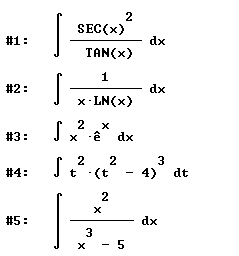
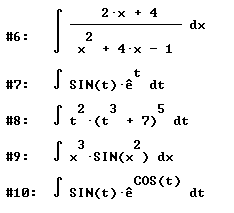
Calculus II Class 02/07
click here for an extensive set of very basic integrals
Find the derivative of each of the following:
y = x^2 e^x
y = sqrt(sin(t))
y = e^x / cos(x)
y = cos(t^2)
y = e^(x^3)
y = x^3 e^x
y = ln(sqrt(x))
y = e^-(x^2)
Does each of the following look like a substitution situation or an integration by parts situation, both or neither? Specify the substitution or breakdown into u and dv you would use for each:
integral(sec^2(x) / tan(x), x)
integral(1 / ( x ln(x)), x)
integral(x^2 e^x, x)
integral(t^2 ( t^2 - 4)^3, t)
integral(x^2 / (x^3 - 5), x)
integral((2x + 4) / (x^2 + 4 x - 1), x)
integral(sin(t) e^t, t)
integral(t^2 (t^3 + 7)^5, t )
integral(x^3 sin(x^2), x)
integral(sin(t) e^cos(t),t)


We integrate 1 / [ (x-2)(x+5) ] using partial fractions:
Express A / (x-2) + B / (x+5) as a single fraction, with a single numerator and a single denominator.
If 1 / [ (x-2)(x+5) ] = A / (x-2) + B / (x+5) then what are the values of A and B?
With 1 / [ (x-2)(x+5) ] expressed in the form A / (x-2) + B / (x+5) , what is the integral of the expression with respect to x?
We integrate 1 / [ (x-2)(x^2+5) ] using partial fractions:
Express A / (x-2) + ( B x + C) / (x^2+5) as a single fraction, with a single numerator and a single denominator.
If 1 / [ (x-2)(x^2+5) ] = A / (x-2) + ( B x + C) / (x^2+5) then what are the values of A and B?
With 1 / [ (x-2)(x^2+5) ] expressed in the form A / (x-2) + ( B x + C) / (x^2+5) , what is the integral of the expression with respect to x?
Check out the assertion made last time that integral (1 / sqrt(t-2), t, 1, 3) does indeed converge.
For t > 1 how does the graph of y = 4 / (t-.5)^2 compare with the graph of y = 1 / t and the graph of 1 / t^1.01? What does this comparison tell you about the convergence or divergence of y = 4 / (t-.5)^2?
NOTES ARE NOT COMPLETELY ORGANIZED YET, WILL BE SOON.
Sketch the graph of y = 1 / (t - 2)^2 from t = 0 to t = 4.
Find the integral of y = 1 / (t - 2)^2 from t = 1 to t = 3.
Find the integral of y = 1 / (t - 2)^2 from t = 0 to t = 4.
Do your results agree with your picture (look at the area under the curve for each interval)? If not, what's wrong here?
Among other things the graph of y = 1 / (t-2)^2 is positive for all t > 0 for which the expression is defined.
Antiderivative of f(t) = 1 / (t-2)^2 is easily found by the substitution u = t - 2 to be F(t) = -1 / (t - 2).
The integral of f(t) from t = 1 to t = 3 is therefore F(3) - F(1) = -1 / (3-2) - ( -1 / (1-2) ) = -1 - 1 = -2.
The integral of f(t) from t = 0 to t = 4 is therefore F(4) - F(0) = -1 / (4-2) - ( -1 / (0-2) ) = -1/2 - 1/2 = -1.
Neither of these results makes any sense.
The key is that the function has a vertical asymptote at t = 2, and is therefore not defined through either of the intervals t = 1 to t = 3 or t = 0 to t = 4.
To integrate we have to integrate everything to the left of t = 2, then everything to the right of t = 2.
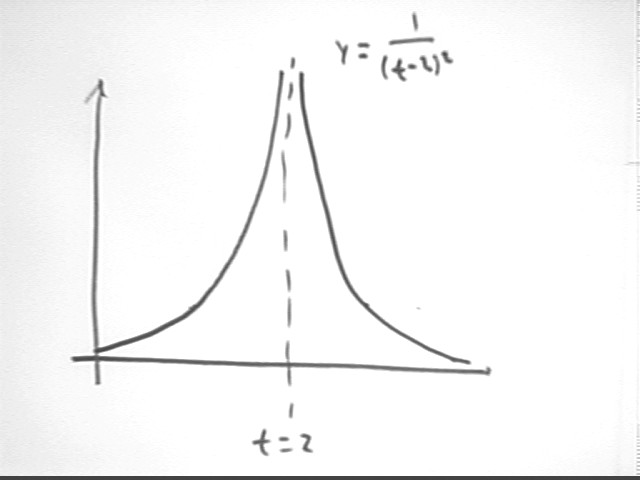
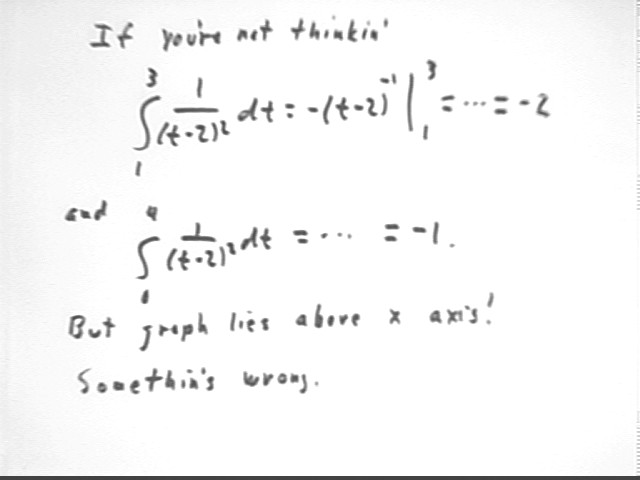
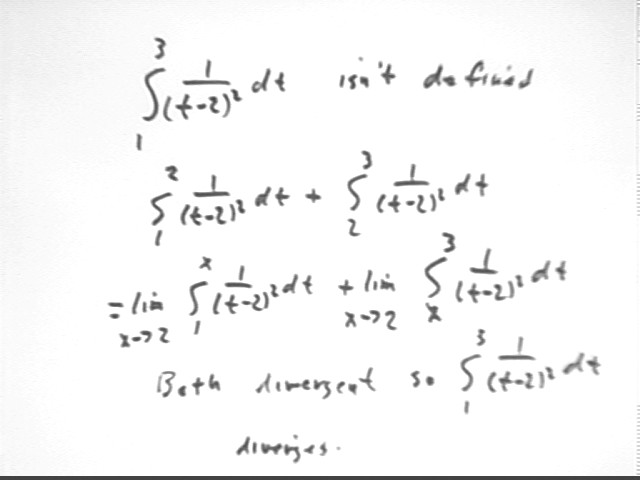
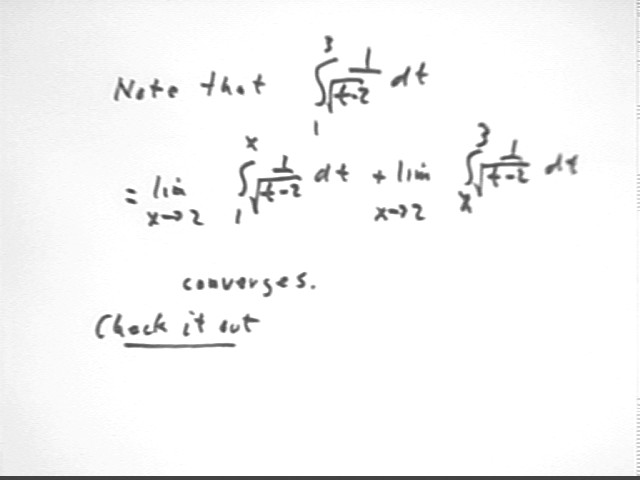
Does the integral from t = 1 to infinity of y = 1 / t converge or diverge? Hint: Look at the limiting value of the integral from 1 to x, as x -> infinity.
integral (1/t, t, 1, infinity) = lim(x -> infinity) integral(1/t, t, 1, x) = lim(x -> infinity) ( ln x - ln 1) = lim (x -> infinity) (ln x).
If ln x is bounded as x -> infinity then there would be some number N which ln x cannot exceed. In this case we would have
ln x < N for all x.
But this is the same as saying that x < e^N for all x. But this cain't be since x = e^N + 1, for example, is a perfectly good number which is bigger than e^N.
It follows that our integral is divergent.
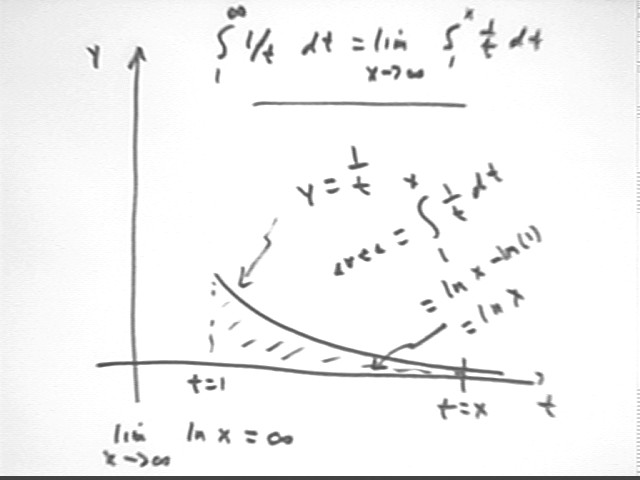
Does the integral from t = 1 to infinity of y = 1 / t^1.01 converge or diverge? Hint: Look at the limiting value of the integral from 1 to x, as x -> infinity.
Antiderivative of 1 / (t^1.01) = t^-1.01 is the antiderivative of t^n, which is 1 / (n+1) t^(n+1), with n = 1.01. So we get antiderivative F(t) = 1 / (1 - 1.01) * t^(-1.01 + 1) = -100 t^-.01 = -100 / t^.01.
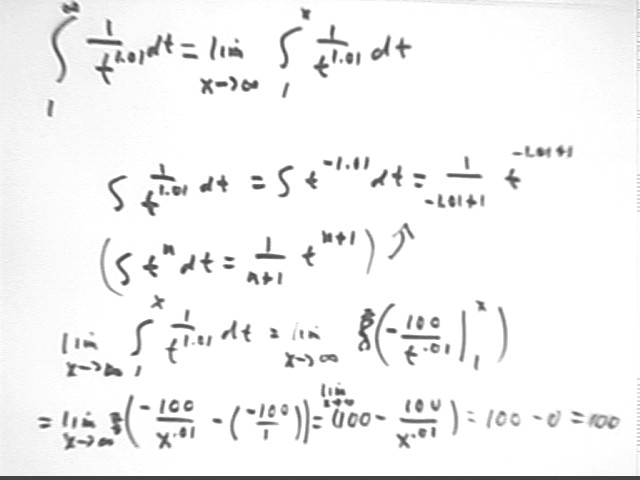
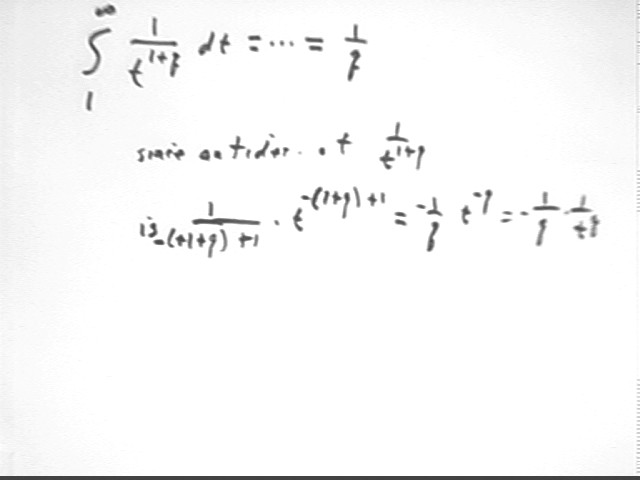
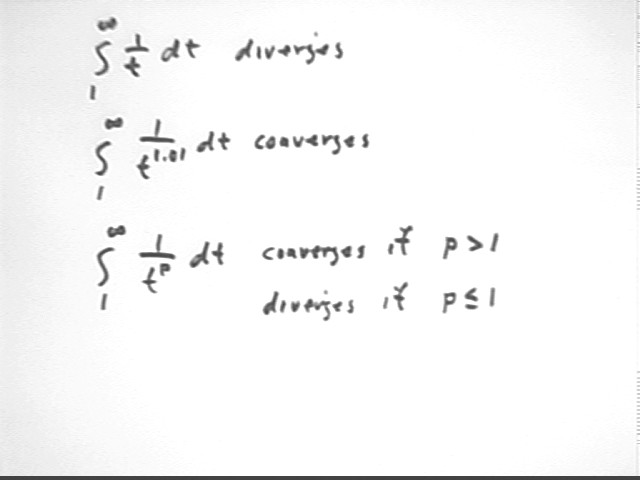
Does the integral from t = 0 to infinity of y = e^-.003 t converge or diverge? Hint: Look at the limiting value of the integral from 1 to x, as x -> infinity.
For t > 1 how does the graph of y = 1 / (t * e^t) compare with the graph of y = 1 / t and the graph of 1 / t^1.01? What does this comparison tell you about the convergence or divergence of y = 1 / (t * e^t)?
For t > 1 the graph of 1 / (t e^t) lies always below the graph of 1 / t.
The integral from 1 to infinity of 1/t diverges. That area grows beyond all bounds as we move to the right.
If another graph lies always above the graph of 1/t then it will contain an area that grows beyond all bounds and its integral will also diverge.
If another graph lies always below the graph of 1/t then might possibly diverge, but we don't know for sure because lots of convergent functions (e.g, 1/t^2) will lie below the graph of 1/t.
So we can't draw any conclusions from this comparison of 1/(t e^t) with 1/t.
However comparing 1 / (t e^t) with 1 / t^1.01 we first note that if 1 / (t e^t) lies lower than the convergent 1 / t^1.01, then since the graph of the convergent 1 / t^1.01 can't 'contain' an infinite area, the integral of 1 / (t e^t) must converge.
The inequality 1 / (t e^t) < 1 / t^1.01 gives us t^.01 < e^t. This is true for t = 1, since 1 < e, and since e^t grows faster than any power function (remember l'hopital) the inequality will hold for all t > 1.
It follows that the integral from 1 to infinity of 1 / (t e^t) converges.
For t > 1 how does the graph of y = 1 / ln(t) compare with the graph of y = 1 / t and the graph of 1 / t^1.01? What does this comparison tell you about the convergence or divergence of y = 1 / ln(t)?
For t > 1 how does the graph of y = 4 / (t-.5)^2 compare with the graph of y = 1 / t and the graph of 1 / t^1.01? What does this comparison tell you about the convergence or divergence of y = 4 / (t-.5)^2?
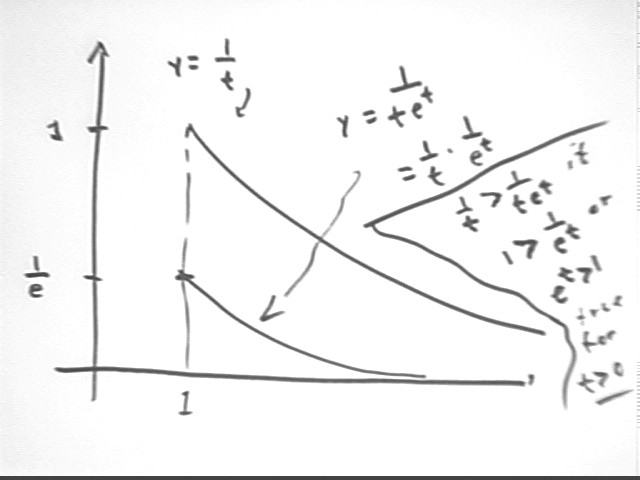
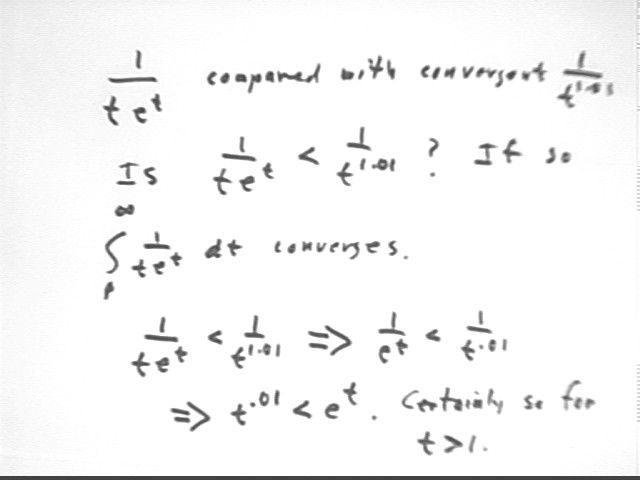
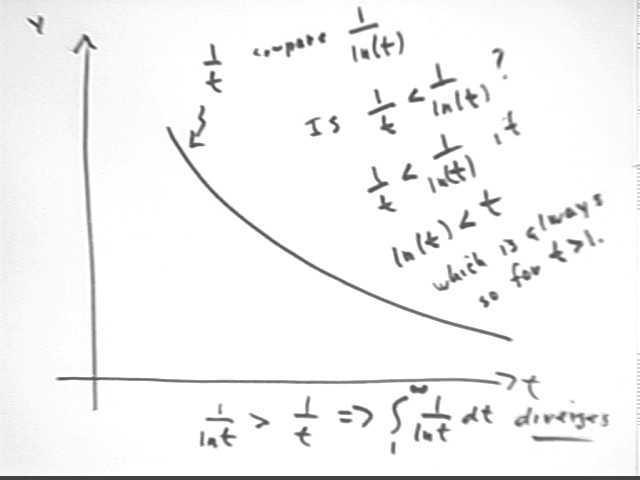
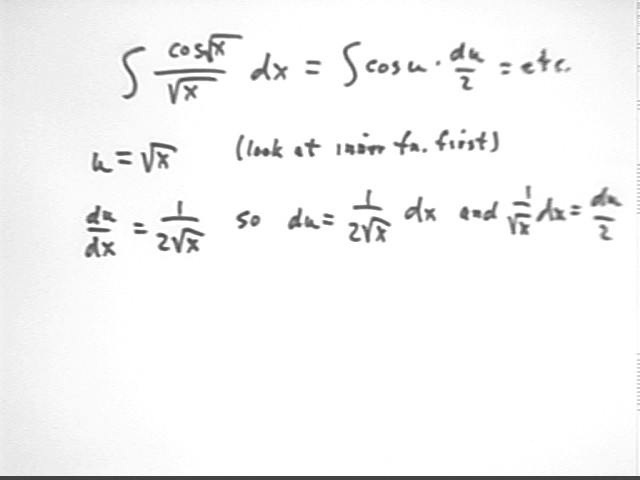
First thing to try for substitution, which 'undoes' composites:
1. Look for the inner function of a composite. Try u = that function.
2. Figure out du/dx, then du.
3. Get constants over there with the du.